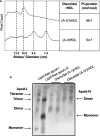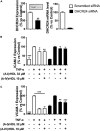Inhibition of Vascular Inflammation by Apolipoprotein A-IV
- PMID: 35845068
- PMCID: PMC9279673
- DOI: 10.3389/fcvm.2022.901408
Inhibition of Vascular Inflammation by Apolipoprotein A-IV
Abstract
Background: Apolipoprotein (apo) A-IV, the third most abundant apolipoprotein in human high density lipoproteins (HDLs), inhibits intestinal and systemic inflammation. This study asks if apoA-IV also inhibits acute vascular inflammation.
Methods: Inflammation was induced in New Zealand White rabbits by placing a non-occlusive silastic collar around the common carotid artery. A single 1 mg/kg intravenous infusion of lipid-free apoA-IV or saline (control) was administered to the animals 24 h before collar insertion. The animals were euthanised 24 h post-collar insertion. Human coronary artery cells (HCAECs) were pre-incubated with reconstituted HDLs containing apoA-IV complexed with phosphatidylcholine, (A-IV)rHDLs, then activated by incubation with tumour necrosis factor (TNF)-α. Cell surface vascular cell adhesion molecule-1 (VCAM-1) and intercellular adhesion molecule-1 (ICAM-1) in the TNF-α-activated HCAECs was quantified by flow cytometry. VCAM-1, ICAM-1 and 3β-hydroxysteroid-Δ24 reductase (DHCR24) mRNA levels were quantified by real time PCR.
Results: Apolipoprotein ApoA-IV treatment significantly decreased collar-induced endothelial expression of VCAM-1, ICAM-1 and neutrophil infiltration into the arterial intima by 67.6 ± 9.9% (p < 0.01), 75.4 ± 6.9% (p < 0.01) and 74.4 ± 8.5% (p < 0.05), respectively. It also increased endothelial expression of DHCR24 by 2.6-fold (p < 0.05). Pre-incubation of HCAECs with (A-IV)rHDLs prior to stimulation with TNF-α inhibited VCAM-1 and ICAM-1 protein levels by 62.2 ± 12.1% and 33.7 ± 5.7%, respectively. VCAM-1 and ICAM-1 mRNA levels were decreased by 55.8 ± 7.2% and 49.6 ± 7.9%, respectively, while DHCR24 mRNA expression increased by threefold. Transfection of HCAECs with DHCR24 siRNA attenuated the anti-inflammatory effects of (A-IV)rHDLs. Pre-incubation of TNF-α-activated HCAECs with (A-IV)rHDLs also inhibited nuclear translocation of the p65 subunit of nuclear factor-κB (NF-κB), and decreased IκBα phosphorylation.
Conclusion: These results indicate that apoA-IV inhibits vascular inflammation in vitro and in vivo by inhibiting NF-κB activation in a DHCR24-dependent manner.
Keywords: 3β-hydroxysteroid-Δ24 reductase; apolipoprotein A-IV; endothelial cells; high-density lipoproteins; inflammation; nuclear factor-kappaB.
Copyright © 2022 Shearston, Tan, Cochran and Rye.
Conflict of interest statement
The authors declare that the research was conducted in the absence of any commercial or financial relationships that could be construed as a potential conflict of interest.
Figures







Similar articles
-
Role of 3beta-hydroxysteroid-delta 24 reductase in mediating antiinflammatory effects of high-density lipoproteins in endothelial cells.Arterioscler Thromb Vasc Biol. 2009 Jun;29(6):877-82. doi: 10.1161/ATVBAHA.109.184663. Epub 2009 Mar 26. Arterioscler Thromb Vasc Biol. 2009. PMID: 19325144
-
High-density lipoproteins inhibit vascular endothelial inflammation by increasing 3β-hydroxysteroid-Δ24 reductase expression and inducing heme oxygenase-1.Circ Res. 2013 Jan 18;112(2):278-88. doi: 10.1161/CIRCRESAHA.111.300104. Epub 2012 Nov 4. Circ Res. 2013. PMID: 23123430
-
The apolipoprotein A-I mimetic peptide ETC-642 exhibits anti-inflammatory properties that are comparable to high density lipoproteins.Atherosclerosis. 2011 Aug;217(2):395-400. doi: 10.1016/j.atherosclerosis.2011.04.001. Epub 2011 Apr 16. Atherosclerosis. 2011. PMID: 21571275
-
Low dose apolipoprotein A-I rescues carotid arteries from inflammation in vivo.Atherosclerosis. 2008 Jan;196(1):240-247. doi: 10.1016/j.atherosclerosis.2007.05.008. Epub 2007 Jun 27. Atherosclerosis. 2008. PMID: 17586510
-
Postprandial lipoproteins and the molecular regulation of vascular homeostasis.Prog Lipid Res. 2013 Oct;52(4):446-64. doi: 10.1016/j.plipres.2013.06.001. Epub 2013 Jun 15. Prog Lipid Res. 2013. PMID: 23774609 Review.
Cited by
-
Muscle Transcriptome Sequencing Revealed Thermal Stress-Responsive Regulatory Genes in Farmed Rohu, Labeo rohita (Hamilton, 1822).Mar Biotechnol (NY). 2023 Dec;25(6):1057-1075. doi: 10.1007/s10126-023-10259-8. Epub 2023 Oct 25. Mar Biotechnol (NY). 2023. PMID: 37878212
-
Apolipoprotein A-IV concentrations and cancer in a large cohort of chronic kidney disease patients: results from the GCKD study.BMC Cancer. 2024 Mar 7;24(1):320. doi: 10.1186/s12885-024-12053-8. BMC Cancer. 2024. PMID: 38454416 Free PMC article.
-
Plasma apolipoprotein concentrations and occurrence of cardiovascular events in the general population: an exploratory analysis.Atheroscler Plus. 2025 May 8;60:35-42. doi: 10.1016/j.athplu.2025.04.003. eCollection 2025 Jun. Atheroscler Plus. 2025. PMID: 40485857 Free PMC article.
-
DHCR24 in Tumor Diagnosis and Treatment: A Comprehensive Review.Technol Cancer Res Treat. 2024 Jan-Dec;23:15330338241259780. doi: 10.1177/15330338241259780. Technol Cancer Res Treat. 2024. PMID: 38847653 Free PMC article. Review.
-
Gut Hormones and Inflammatory Bowel Disease.Biomolecules. 2025 Jul 14;15(7):1013. doi: 10.3390/biom15071013. Biomolecules. 2025. PMID: 40723884 Free PMC article. Review.
References
-
- Nicholls SJ, Dusting GJ, Cutri B, Bao S, Drummond GR, Rye KA, et al. Reconstituted high-density lipoproteins inhibit the acute pro-oxidant and proinflammatory vascular changes induced by a periarterial collar in normocholesterolemic rabbits. Circulation. (2005) 111:1543–50. 10.1161/01.CIR.0000159351.95399.50 - DOI - PubMed
Publication types
LinkOut - more resources
Full Text Sources
Miscellaneous

